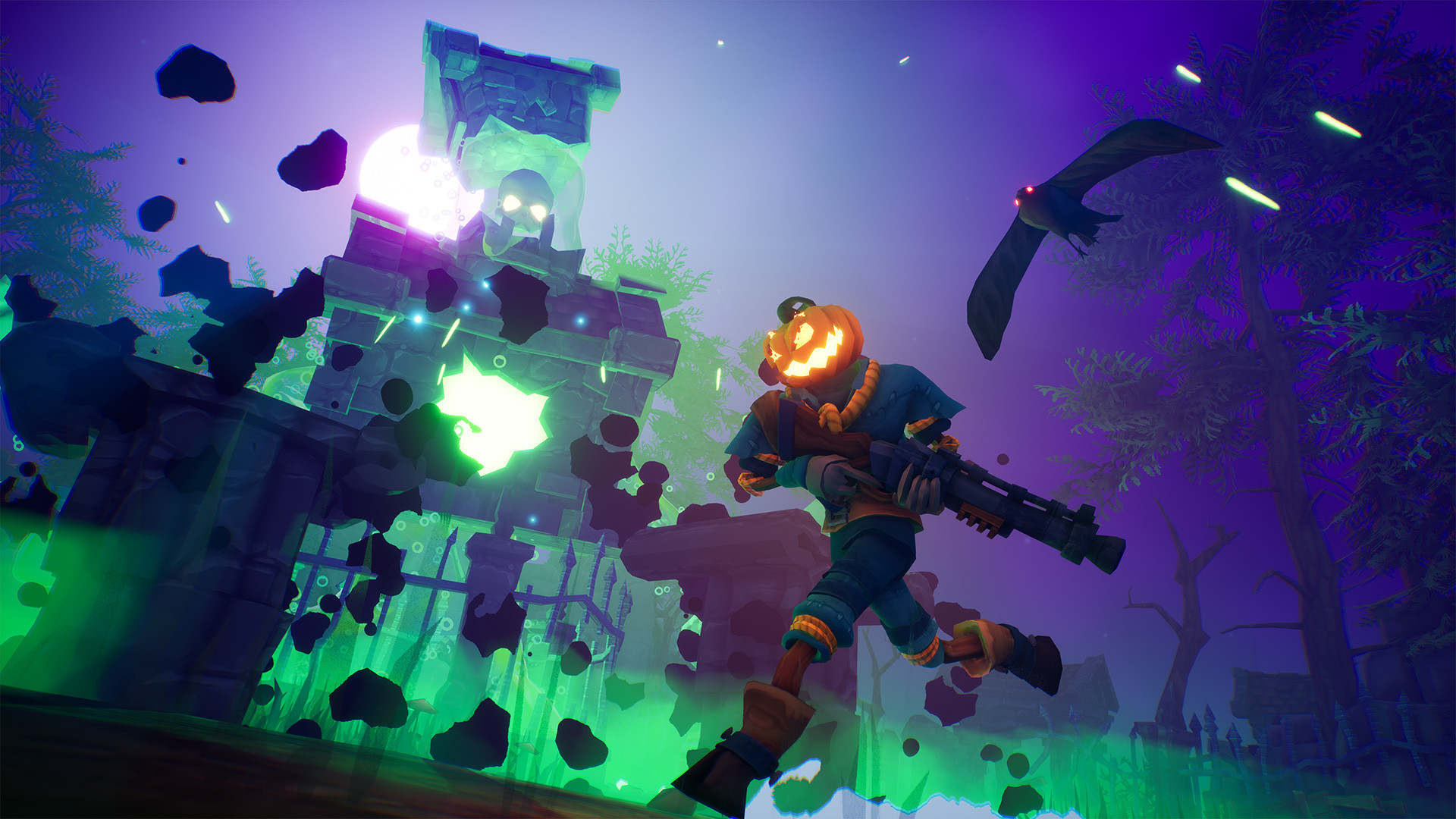Hidden Gems of Game Design: Volume 5
Our team is back with another set of games that deserve more attention than they get

There are plenty of amazing games that go unnoticed and are not widely played for one reason or another. Maybe it's a diamond in the rough, or the marketing wasn't there, or it could be a game ahead of its time. For this monthly series, I've asked my fellow writers on SUPERJUMP to pick a game they think is deserving of a chance in the spotlight. Let us know your favorite hidden gems in the comments.
Josh Bycer
Fear and Hunger (2018)
October means horror and while I’m also participating in the Halloween collaboration here on Superjump, there are plenty of horror games to go around. For my pick this month, I have what is without a doubt one of the most brutal games ever released, Fear & Hunger by Miro Haverinen.

The story holds that there is a mysterious dungeon in the world where evil has gone to fester - a place where gods and devils alike have taken root, the dungeon known as Fear & Hunger. You play as one of four different classes/people who have different reasons for going to the dungeon. Your mission is to get in, find what you’re looking for, and hopefully get out alive.
There are people out there who say they have played tough games like Souls-likes, Doom, Call of Duty, etc., but they are just sweet innocent lambs when it comes to Fear & Hunger. This is one of the few games on Steam that has a deservedly warranted “Adults only” tag attached to it that is not related to the porn game genre.
Let’s start with the story and surroundings. Every area of the game is randomly shuffled with each new play – with a post-release update adding in an even harder variant to go through. This is a big deal because you are going to be scavenging for any and all food, healing items, and gear, to even stand a remote chance of winning. Characters can learn magic and the right spells can trivialize a lot of enemies, but enemies have their own spells as well.

The major path through the game to one of the many endings will take you through a variety of vignettes and disturbing scenes. One room is full of dead bodies, and then you can stumble upon an orgy, and those are considered the “lighter” events. There are no random encounters; enemies wander around the halls and caverns giving chase if they see you.
This brings us to the game's combat, and how Fear & Hunger makes it abundantly clear that combat is high risk. Both the player and enemies can target specific body parts that will affect how the person fights. Chop off someone’s arm who’s holding an axe, and they won’t be able to do the same to you. A lot of combat is more puzzle-like with you trying to figure out which parts to destroy to weaken the enemy for a decapitation…if cutting off their head will actually stop them.
However, remember that you can also be targeted by enemy attacks. If an enemy knocks off one of your limbs, your character will be permanently disabled for the rest of the run, with very few ways to get those limbs back. And that doesn’t include getting a myriad of diseases, status ailments, starving to death, dying of thirst, and other ways of losing.

Now, you may think that the game sounds hard enough, but wait, there’s more. Every decision and event that can happen will always have the impact of a coin flip. This can mean the difference between unlocking a powerful ability or summoning the face of Cthlulu who will cause you to die. And when I say every event, this also includes finding gear and the act of saving. This is a game where you can find a full set of powerful armor in the first area, or get every bad roll and come away with nothing.
Let me explain how “saving” might go for you:
- Step 1: You have a normal save in a bed.
- Step 2: The room is now marked as dangerous and you have to do a safety check roll.
- Step 3: You fail the roll and go to sleep.
- Step 4: A man with a crow head shows up.
- Step 5: The man with a crow head chops your arms off and summons crows to rip your head off.
- Step 6: You die
Given the extreme difficulty of Fear and Hunger, you might be wondering why people play this. This is a game that is as much about figuring out how things work as it is about breaking the systems. Once you get good enough at the game and understand the basics, you are able to blaze through combat with the right spells and skills. There is a certain pragmatic approach to playing this game – every room and event is a risk you need to weigh in terms of whether or not you can survive. People who do learn this game can easily get through the difficult sections unless RNG completely fails them.
Fear and Hunger is not a game for everyone, but it is a really great example of a game adhering to a specific vision and mission statement. For anyone who likes their games on the challenging side, and doesn’t mind very disturbing scenes and violence, then you own it to yourself to step into the dungeon of Fear and Hunger at least once, or wait for the sequel that is “coming soon.”
Drawn Stories
Eliza (2019)
What happens when a team, known for tough, open-ended puzzles, goes and makes the opposite kind of game... a linear visual novel? Well, I have a sample size of 1, but Zachtronics managed to create a thoughtful story about technology, and mental health, all wrapped in a neat presentation.
The game is named after the in-game's ELIZA (which in turn is named after the real-life's chatbot from the 60s) an AI counseling service where the only human interventions are "proxies", agents who read the script provided by ELIZA to the clients. But what happens when humans are reduced to a bunch of numbers to be solely interpreted by a machine? Is this providing mental health care to people who otherwise couldn't get it? Or just dehumanizing patients?

You'll see both the side of developers and the hopes they have for this emerging technology, and the actual clients receiving counseling. Concerns about how far technology could and should go regarding concerns about privacy and big data, and the possibility of alternative technologies to prevent negative emotions altogether and what they might mean for humankind.
The game lets you absorb a bit more information if you choose to, as your phone will be available often, and there you can find more details from messages or emails. Or you can forget about the game for a bit, and relax with a game of solitaire.
The one thing I can reproach is that, even for a visual novel, it's pretty linear, with most choices being pretty inconsequential to the ending except for those taken in the last chapter. That doesn't stand in the way of recommending this title that varies so wildly from its developers other projects.
CJ Wilson
Pumpkin Jack (2020)
It’s the spookiest time of the year. The weather is becoming colder and crisper, the leaves are changing colors, and Halloween lets us experience a myriad assortment of horror games. But sometimes you might want to play something that isn’t a traditional mainstream horror title like Resident Evil or Outlast. Maybe you want to check out a game that is a bit under the radar. The game you should check out during the Halloween season is Pumpkin Jack.

Pumpkin Jack is a 3D platformer, primarily made by one person, where you play as a trickster spirit named Jack inhabiting a pumpkin for a head. He is serving the Devil himself as you are tasked with stopping a wizard from saving the world. In exchange you will be sent to the Afterlife by having your past misdeeds expunged. You unlock new weapons as you beat the various bosses in the game’s six levels that you can use to take out the various enemies that stand in your way.
What makes this game stand out is the myriad variety of gameplay styles that are present. At certain points in the game, you will come across pumpkin-shaped pillars that make your character Jack take off his head, from whence you control said head to complete various puzzles. These creative sublevels require careful thinking as you either have to create a path for a bomb in one section or perform a matching game by smashing headstones in a cemetery.
The combat itself is fairly straightforward; you'll move and dodge out of the way, utilizing various weapons like a shovel or shotgun that are quickly swappable. You have a crow as your ally that you can send after enemies with its long-range attack. While the game doesn’t have a fleshed-out combo system, you can usually fight back without any issues as you can also destroy different objects within the environment. These can grant you energy to regain your health along with reaching the different checkpoints scattered throughout the levels.

One of Pumpkin Jack’s greatest strengths as a horror game is its colorful and cartoony environments. Each level has an atmosphere that invokes the Halloween aesthetic by featuring graveyards, swamps, and cathedrals that feels right at home without being overly creepy or terrifying. Many of the environments feature dynamic lighting effects that set the mood perfectly, invoking that classic graphical style as seen in PS2 titles like Jak & Daxter and Medievil.
Like any platforming game, you will come across certain collectibles as you progress through the level. Here you'll be searching for crow skulls that you find either by fighting off a specific number of enemies or by going off the main path by traversing through the environment. There are also gramophones found within each level that give you a fun, amusing animation where you see Jack dancing like it’s no tomorrow.
The crow skulls can be traded into an undead-clothing seller inspired by the merchant from Resident Evil 4 where you can choose which skin you want to wear. Having the option gives you a feeling like you are getting ready to go out trick or treating by wearing costumes like a cowboy or a samurai among others.

As you continue to play through Pumpkin Jack, you will notice that it isn’t challenging in any regard. For me, that’s okay, as you experience a story where you play as the villain trying to stop the good guys from saving the world. That in itself is unique from my viewpoint which makes it stand out from other games in the horror genre, especially indie games of this caliber.
Overall, it’s a simple 3D platformer that will surely make you appreciate the five to six-hour journey into an atmospheric, haunting adventure. So if you're looking for a horror game that isn’t difficult, doesn’t make you scared, and captures the Halloween spirit, then Pumpkin Jack is the game for you.
Ben Cantrell
Forma.8 (2014)
Forma.8 offers an original spin on the Metroidvania formula, with a huge open world, a big focus on exploration, and nicely balanced combat. Created by a two-person indie dev team, Mixed Bag, based in the Italian city of Turin, the game was originally conceived as a mobile-first project with the developers keen to create a game for the iPad and harness the potential of the touch screen for gaming.
Released for iOS and PC in 2014, the game failed to get much traction and seemed destined for obscurity. It was only after release that the devs realised Forma.8 was actually very enjoyable to play with a controller too! A chance meeting with Sony later that year saw them polish the game for an eventual release later on Playstation, alongside Steam, Xbox, Wii U, and eventually on Switch.
Despite being widely available on a range of platforms, Forma.8 has generally flown under the radar and remains a hidden gem for fans of moody and atmospheric Metroidvanias. Those who enjoyed the dark tone of Limbo or the sense of mystery in Tunic will love exploring Forma.8’s diverse landscapes.
Forma.8’s floating movement system takes some getting used to, but after a while, the sense of freedom is satisfying and allows for a lot of verticality and diverse combat encounters. The enemies range greatly, but most often resemble flying robotic insects of varying degrees of agility.
Much like the classic Metroid games from which so much inspiration is drawn here, Forma.8 features a large open world that remains entirely accessible throughout. There’s also a world map which, while lacking in much detail, can provide some guidance on where to go next.
Starting out as a relatively helpless floating ball, vulnerable to even the smallest enemies, players will soon acquire new skills by collecting energy orbs. Available upgrades include the obvious boosts to health and stamina, along with mines that can be flung at enemies, a dash to aid in exploration, and (later in the game) a teleportation device and even camouflage for evading combat altogether.
The big star of the show in Forma.8 is the lovingly crafted open world. There’s a diverse range of landscapes to explore, from organic alien moonscapes to subterranean wastelands and industrial sci-fi prisons. All the areas are filled with puzzles that grow in complexity as the story progresses. There are the obvious head-scratchers like searching for keys and finding hidden switches, while later sections require players to mind-control enemies to evade traps or defeat a boss by luring other enemies into its giant mouth.
There are some heart-pounding chase sequences too, such as when an ominous pink ball chases players through a weaving tunnel and maze of slingshots, reaching safety with only milliseconds to spare.
While many areas in Forma.8 are dense and claustrophobic, there are also some expansive outdoor zones that (combined with the atmospheric score) build a genuine sense of wonder. The game explains very little to the player and leaves much to the imagination. In some ways, this is also one of Forma.8’s only downsides. The sense of mystery is so deep that at times I had trouble identifying with the main character. I wasn’t sure exactly why this black ball was so determined in their quest, as there’s no clearly defined story and at times I felt driven by curiosity alone.
Despite this, Forma.8 is a unique and memorable experience, thoroughly worthwhile for those who’d like to experience another atmospheric and challenging Metroidvania. With the campaign taking between 3-4 hours to complete, it can be enjoyed in one afternoon. Forma.8 is a hidden gem that’s worth exploring.
Antony Terence
Lemonade Tycoon (2003)
Lemonade Tycoon doesn’t have the attention to detail of Microsoft’s Zoo Tycoon (2001) or the explosive potential of Atari’s Rollercoaster Tycoon (1999). Instead, this simulator kept its ambitions small and aimed at your heart. Lemonade Tycoon set its sights on your childhood entrepreneurial dreams, letting you grow from a friendly neighborhood lemonade stand to a massive corporation. Simple controls paired with a basic profit-making gameplay loop meant that I lost no time as a child before diving headlong into the careful art of lemonade making.

The game lets you decide how much ice, water, sugar, and well, lemons, went into a lemonade. Despite being a kid, it was obvious that I had to strike a balance between costs and revenue to make a tidy profit. I didn’t expect a lemonade stand to teach me cost-benefit analysis but here we are. It’s a skill that has come to my aid countless times across both strategy games and real life.
Soon enough, the lemonade stand started making bigger demands of my little mind.
Expansion meant dealing with the delicate balance of location, skyrocketing rents, and customer satisfaction. Even press headlines could affect the sales of your lemonade at any moment. Add unpredictable weather into the mix and you had plenty of variables that kept things fresh. Nothing sold quicker than lemonade on a hot summer day. And that meant price hikes weren’t a bad idea.
As you grew out of the suburbs, so did your customer base. Time became a valuable resource and upgrades like an ice maker or a fridge let me turn life’s lemons into a ripe profit.

Sure, there are plenty of simulation games out there.
Most of them deal with grand zoos and exotic theme parks or cities whose towers scrape the sky. But I’m glad that a studio thought of making a lemonade stand simulator instead. EA released an updated mobile variant back in 2009 and it surprisingly didn’t cost a dime. It’s a testament to how great things can come from simple ideas and straightforward execution. Here’s a nudge to give Lemonade Tycoon a shot. Go on, turn lemons into something greater.




